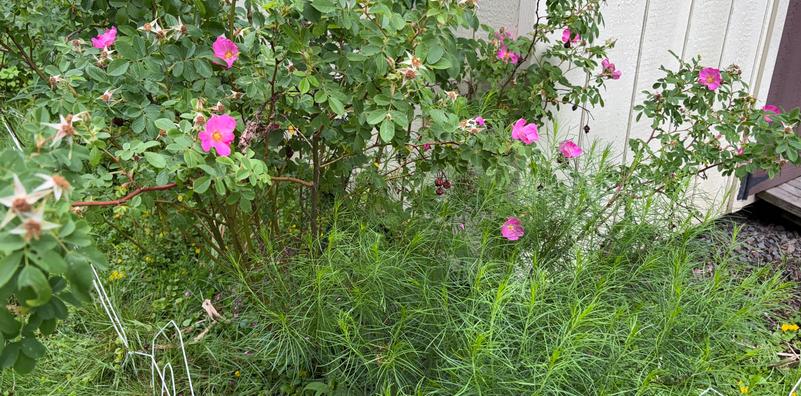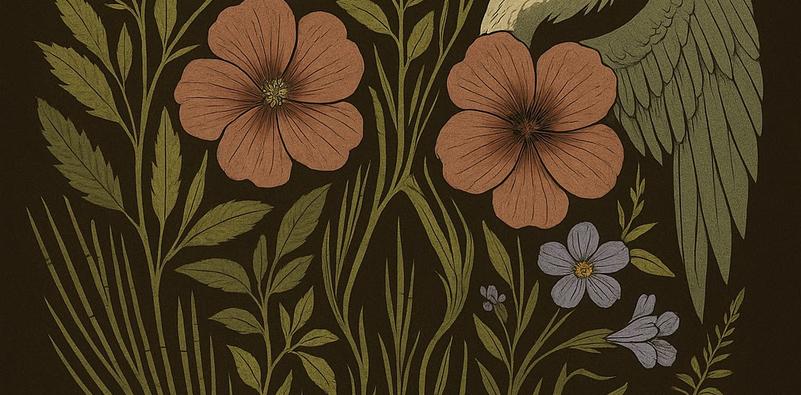Tales from the Misfit Garden
Sometimes, our best laid plans not only go to waste, but plummet to hell in a handbasket as we wonder where we went wrong. Over the last four years as I’ve chipped slowly away at my swampy Pennsylvanian yard, incorporating facultative wetland plants into the inundated soil and more lenient selections along the (slightly) drier fence line, I’ve watched with curiosity and occasional chagrin as some things thrive and other things gasp their last pathetic breaths, cursing me for placing them in poorly planned spots.
Throughout the four years that I’ve been tending this space, I’ve had the pleasure of watching the plants that are truly thriving intermingle amongst one another, creating interwoven patchworks of textures, colors, shapes, sizes, and eco-benefits for an ever-growing population of insect pollinators that weren’t found in my yard before my intervention. After accepting that some standard plant staples would never adapt to my sopping wet soils, I began leaning into the idea that, fine, maybe I’ll just work with the situation at hand instead of trying to fight it tooth and nail. In that time of acceptance, my yard has never seemed happier. Despite many of my selections beginning as half-dead or soon-to-be-culled stragglers, and my attempt at reviving them by giving them a place to spend their potential final days, the ones that have managed to pull through have become not only some of my favorite selections in my space, but have also proven to be some of the toughest and fool-hardy plants (especially for difficult, overly-saturated clay soils).
Of these notable selections, Rosa palustris (swamp rose) has become one of my most prized plant possessions, and despite only being two years old, has started establishing itself outside of its mother plant. Amidst the Eupatorium perfoliatum that hosts various insect pollinators each summer, from moths to wasps to hover flies, a single stem of Rosa palustris emerges upright with a single terminal flower bud making an appearance above the rugose, heavily textured, opposite leaves of our native boneset. Opposite the boneset and on the other side of the swamp rose lives an ever-expanding Amsonia hubrichtii, which never fails to impress me with its icy blue blooms and delicate, skinny leaves as a visual bane to the larger, medium green leaves of its rose companion.
Meanwhile, Aronia melanocarpa ‘Viking’ has happily occupied two sites in my swampy space - one in a lower, wet area, and the other on a wooded slope – and wouldn’t you know it, both are full of fruits, proving their value as early spring pollinator resources for nectar and pollen. In the wettest but my most favorite part of the yard lives a collection of plants that, from afar, may appear a bit chaotic and untended, but has exceeded my expectations for a small wetland garden over the last handful of years. Once a young, 24” tall specimen, my now mature 4’ x 4’ Cephalanthus occidentalis creates a low-hanging canopy for European starlings, redwing blackbirds, American robins, and mallard ducks to take shelter beneath. Around any given side of my buttonbush, one can find Chelone glabra, Filipendula rubra ‘Venusta’, Juncus effusus, Iris fulva, and Iris versicolor happily occupying space above the layer of leaf mulch. Equisetum hyemale, now three years established, butts up against the chainlink fence but is not inhibited by this barrier, and can be found pushing up new shoots on either side. Mimulus ringens (Allegheny monkeyflower) sits proudly between the horsetail and queen-of-the-prairie, and despite only having been in the space for a little under a year, is showing great promise in terms of its eventual expansion throughout the wetland patch.
For every plant that thrives in this space, two or three have died, due largely in part to my over-optimism. This brings us back to the old adage of best laid plans going to waste - some of the things I carefully incorporated and doted over seemed to die more enthusiastically than the things I’d left to their own devices. Ironically, some of the plants I wasn’t sure were going to make it at all have not only gone on to out-do seemingly healthier plants, but have become pinnacle moments in my yard. After four years of catering to a site that I was completely daunted by in the beginning, I’ve grown, like my plants, to have a true appreciation for natural spaces that seem impossibly barren and difficult to train. After all, while our best intentions and plans may not go as hoped, it’s often the journeys and experiences learned along the way that metamorphose into delightfully unexpected outcomes.
Planning a Wetland Garden? Here are this week’s mentioned selections, for easy adding to your next order:
Amsonia hubrichtii | Eastern bluestar | (948) #1’s available
Aronia melanocarpa ‘Viking’ | black chokeberry | (#3’s and #7’s available 7/15)
Cephalanthus occidentalis | buttonbush | (#3’s available 7/15)
Chelone glabra | turtlehead | (#1’s available 7/15 & 9/1)
Equisetum hyemale | horsetail | (#1’s available 7/15)
Eupatorium perfoliatum | boneset | (133) #1’s available
Filipendula rubra ‘Venusta’ | queen-of-the-prairie | (249) #2’s available
Iris versicolor | Northern blue flag | (24) quarts available | (#1’s available 7/15)
Juncus effusus | soft rush | (296) #1’s available
Mimulus ringens | Allegheny monkeyflower | (88) #1’s available
Rosa palustris | swamp rose | (93) #3’s available
Onoclea sensibilis | sensitive fern | (#1’s available 9/1)

Rosa palustris flowers and shrub paired with Amsonia hubrichtii. Right: Filipendula rubra 'Venusta' and Cephalanthus occidentalis create a dense thicket in the wetland corner.

